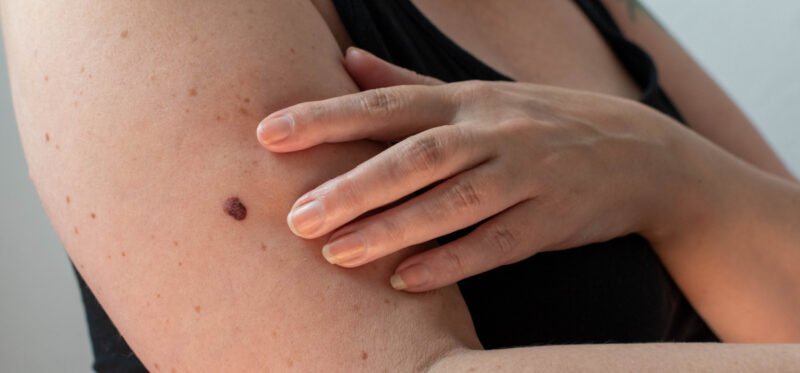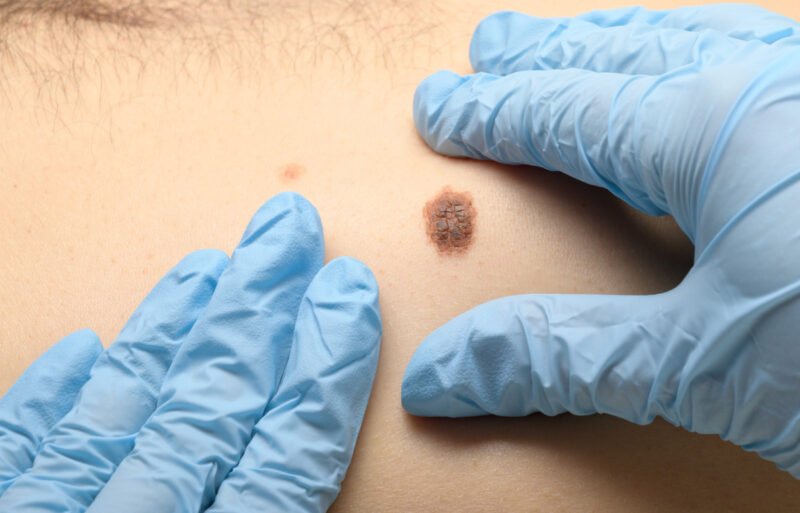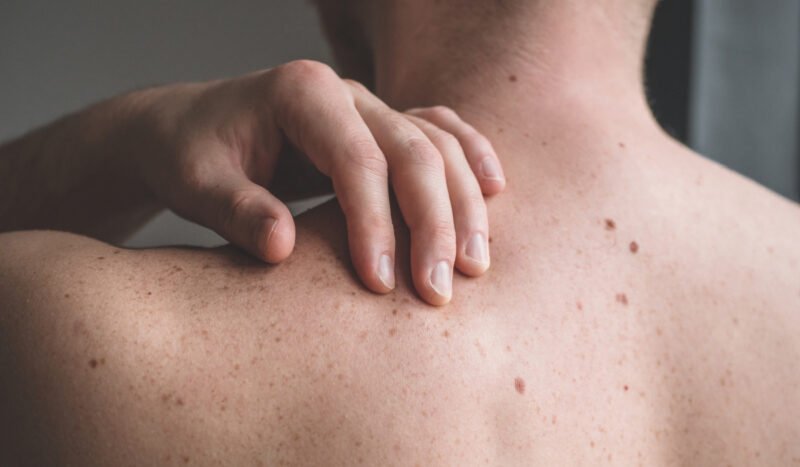Modified Mohs Surgery

Mohs and Modified Mohs surgery are very similar procedures performed to remove certain skin cancer tumors.
Mohs Surgery
Mohs surgery, or Mohs micrographic surgery, is surgery to remove a skin cancer by progressively removing cancerous cells. Mohs surgery involves removing skin cancer layer by layer and examining the tissue under a microscope until healthy, cancer-free tissue around the tumor is reached (called clear margins).
Mohs surgery is a procedure that was developed in the 1930s by Dr. Frederic Mohs. Today, the procedure boasts a high cure rate and is one of the best choices for treatment of skin cancer, particularly Basal Cell Carcinoma and Squamous Cell Carcinoma.
“Dr. Garazo is an artist and his medium is skin. He has completed each of my Mohs surgery repairs beautifully. His staff is knowledgeable and very compassionate. I highly recommend them.”
—Real patient review
What is modified Mohs Surgery?
Modified Mohs surgery is a form of Mohs micrographic skin surgery in which a qualified surgeon meticulously removes cancerous tissue and employs the use of a microscope to evaluate and map out skin cancers.
During the modified Mohs procedure, sections of cancerous tissue are removed incrementally. Each excision of tissue is then sent immediately to the hospital pathology lab for immediate examination or “frozen section” evaluation under a microscope. This technique is often used by surgeons in conjunction with a pathologist to “clear” a cancer intraoperatively. If the cancer extends beyond the excised tissue, the process is repeated until all cancer cells are eradicated. Since tumors are typically larger than they appear and can have roots that extend into deeper layers of tissue, it is vital that the affected area is properly mapped and examined carefully.
- Key Benefits
- Glossary
- High Cure Rate: Modified Mohs surgery offers one of the highest cure rates for skin cancer, particularly for basal cell carcinoma and squamous cell carcinoma, due to its thorough examination of all excised tissue.
- Tissue Conservation: This technique is designed to remove the minimum necessary tissue, preserving as much healthy skin as possible.
- Reduced Recurrence: Modified Mohs surgery reduces the risk of skin cancer recurrence because it ensures the complete removal of cancerous cells during the procedure.
- Localized Anesthesia: The surgery is performed under local anesthesia, making it safer for patients by reducing the risks associated with general anesthesia.
- Outpatient Procedure: Modified Mohs surgery is usually performed as an outpatient procedure, allowing patients to return home the same day.
- Minimized Scarring: Due to the precision of the technique and the conservation of healthy tissue, Modified Mohs surgery typically results in less scarring compared to other types of surgical interventions for skin cancer.
- Basal Cell Carcinoma (BCC): A type of skin cancer that arises from the basal cells, which are located in the deepest layer of the epidermis; it is one of the most common types of skin cancer treated with Modified Mohs surgery.
- Cancerous Cells: Abnormal cells that divide uncontrollably and can invade nearby tissues or spread to other parts of the body; the target for removal during Modified Mohs surgery.
- Excision: The precise removal of skin cancer layers for examination.
- Frozen Section Histology: A rapid tissue processing method used during Modified Mohs surgery to examine the removed skin cancer layers immediately, ensuring all cancerous cells are excised.
- Incisions: Surgical cuts made in the skin during procedures like Modified Mohs surgery, carefully planned to remove cancerous tissue while minimizing cosmetic impact.
- Local Anesthesia: A type of anesthesia applied to a specific area of the body to prevent pain during surgical procedures, including Modified Mohs surgery, without affecting consciousness.
- Margin of Healthy Tissue: A small border of healthy skin around the tumor that is also removed during surgery to ensure all cancerous cells are excised, minimizing the chance of recurrence.
- Melasma: A common skin condition characterized by dark, discolored patches on the skin, not directly related to Modified Mohs surgery but relevant in discussions about overall skin health and treatment options.
- Mohs Micrographic Surgery: A highly effective surgical technique for removing skin cancers, where layers of cancer-containing skin are progressively removed and examined until only cancer-free tissue remains. Modified Mohs may refer to variations of this technique.
- Mole: A benign growth on the skin, often pigmented, that can be a cosmetic concern or, in some cases, may require evaluation for skin cancer.
- Outpatient Procedure: A medical procedure that does not require an overnight stay at the hospital; Modified Mohs surgery is typically performed on an outpatient basis.
- Recurrence: The return of cancer after treatment; Modified Mohs surgery aims to minimize the risk of skin cancer recurrence by thoroughly examining the tissue margins.
- Skin Cancer: A general term for cancers that form in the skin, including basal cell carcinoma, squamous cell carcinoma, and melanoma, often treated with procedures like Modified Mohs surgery.
- Squamous Cell Carcinoma (SCC): A type of skin cancer that originates in the squamous cells, which make up the middle and outer layers of the skin, and another common target for Modified Mohs surgery.
- Surgical Margin: The border of tissue surrounding a tumor that is removed during surgery; examined in Modified Mohs surgery to ensure it is free of cancerous cells.
- Tissue Conservation: The practice of preserving as much healthy tissue as possible during the removal of cancerous cells, a principle benefit of Modified Mohs surgery.
What happens during the procedure?
The traditional Mohs procedure has the patient wait while an in-house lab technician prepares each piece of excised tissue during their visit. Each specimen is reviewed by the dermatologist, and the entire process can sometimes take several hours to clear a cancer. With modified Mohs, it can take less than an hour to have the skin cancer cleared AND surrounding tissue reconstructed by a plastic surgeon. Once an “all clear” report is obtained from the pathologist at the hospital, all cancerous cells have been removed from the surgical site with a 98% accuracy. The final 100% report usually takes less than 48 hours. Plastic surgical reconstruction may begin immediately that day, or may be performed in a delayed manner. This is all covered by your medical insurance and preauthorized prior to your procedure.

Who is qualified to perform Modified Mohs surgery?
In order to perform the Modified Mohs procedure, many years of training and education must be attained. As a board certified plastic surgeon, Dr. Garazo is well qualified to perform the modified Mohs procedure and has extensive experience as a plastic and reconstructive surgeon. Honored as one of ‘America’s Top Plastic Surgeons,’ Dr. Garazo is an expert when it comes to reconstruction. The same skills he uses in cosmetic surgery will be applied to your cancer reconstruction in order to obtain the best results. Dr. Garazo understands the importance of protecting the maximum amount of healthy tissue and minimizing scarring to deliver the best possible results after healing from a modified Mohs procedure.
Once the procedure is complete and the surgery site is ready for reconstruction, Dr. Garazo may use a number of methods including skin flap or skin grafting techniques, depending on the size of the affected area. Dr. Garazo will take every measure to achieve the best possible cosmetic result from your cancer reconstruction.
Am I a candidate for Modified Mohs surgery?
If you have been diagnosed with a form of skin cancer, you may be an excellent candidate for modified Mohs surgery—a qualified surgeon must evaluate many factors when determining a course of treatment:
- Type of cancer
- Where the cancer occurs on the body
- Size and complexity of tumor growth
- Whether or not the cancer has spread into other tissues
“Such a warm-welcoming place from the moment you walk in the door! The staff and Doctor are friendly and knowledgeable, they provided step by step for the procedure I was getting done which caused me to be calm and excited for it rather than nervous, everything has been going perfect from the surgery to the healing! They went beyond of what I expected. “
—Real patient review, June 2023
How effective is modified Mohs surgery?
When it comes to treating skin cancer, modified Mohs surgery is extremely effective. With a cure rate of over 98%, this procedure is unparalleled in comparison to other forms of skin cancer treatment. Even when other methods have tried and failed, modified Mohs provides the highest chance of success functionally and cosmetically.
Because the surgical site is not stitched or reconstructed until all cancer cells are removed, modified Mohs surgery is also more effective at saving healthy surrounding tissue than other methods. Other skin cancer treatments remove a larger area of flesh in hopes that all cancerous tissue is removed and the surgical site is sutured. In other methods, if the excised tissue is examined and it’s clear that there are still cancerous cells, the site must be reopened and additional procedures must be done.

Modified Mohs surgery has a wonderful reputation and high cure rate when treating common types of skin cancer. Whether it is appropriate for your skin cancer depends on many factors, even beyond those discussed here. Dr. Garazo will discuss these factors with you during your personal consultation.
Dr. Garazo performs modified Mohs surgery with plastic surgery reconstruction at his Quad-A accredited surgical facility, meaning you will not have to worry about coordinating reconstruction with an outside surgeon. Everything can be done at our office.
Dr. Garazo is well-versed in this procedure and has helped thousands of patients overcome skin cancer with pleasing results.
Meet Dr. Henry Garazo

Dr. Garazo is a board-certified plastic surgeon with over 20 years of experience offering aesthetic procedures in the greater Hagerstown, MD area. Known for his thorough, expert, and friendly care, Dr. Garazo is a 6x winner of “Best Plastic Surgeon” in the Herald-Mail Tri-State’s Best Community’s Choice Awards. He prides himself on offering comprehensive, informative consultations and ensures every patient always meets personally with him.
References »
Skin Cancer Foundation. Mohs Surgery: The Most Effective Technique for Treating Common Skin Cancers. (https://www.skincancer.org/treatment-resources/mohs-surgery/) Accessed 4/17/24.
American College of Mohs Surgery. History of Mohs Surgery. (https://www.mohscollege.org/about-acms/history-of-mohs-surgery) Accessed 4/17/24.
Li Q, Li H, Tu P, Yang S. Modified Mohs micrographic surgery in the treatment of cutaneous melanoma. Zhonghua Yi Xue Za Zhi. 2015 Jun 23;95(24):1938-40. Chinese. PMID: 26710698.
Hasan N, Nadaf A, Imran M, Jiba U, Sheikh A, Almalki WH, Almujri SS, Mohammed YH, Kesharwani P, Ahmad FJ. Skin cancer: understanding the journey of transformation from conventional to advanced treatment approaches. Mol Cancer. 2023 Oct 6;22(1):168. doi: 10.1186/s12943-023-01854-3. PMID: 37803407; PMCID: PMC10559482.


